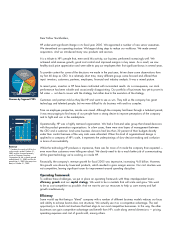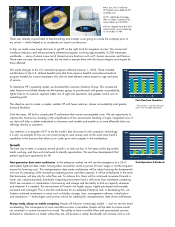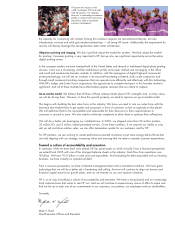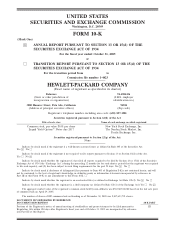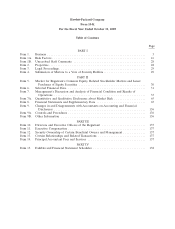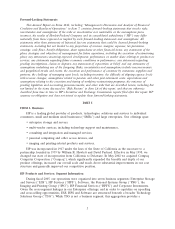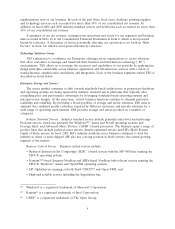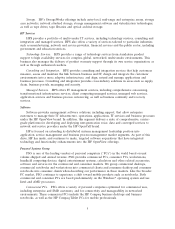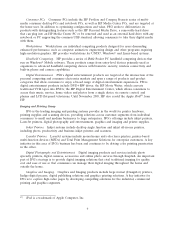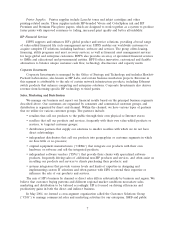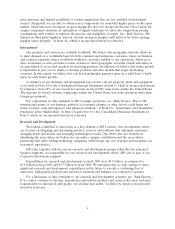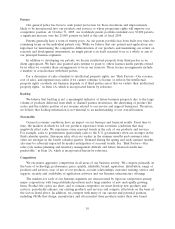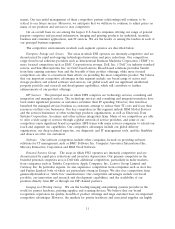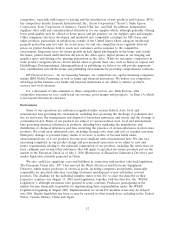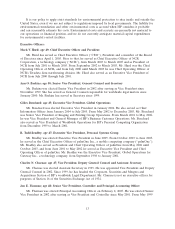HP 2005 Annual Report Download - page 8
Download and view the complete annual report
Please find page 8 of the 2005 HP annual report below. You can navigate through the pages in the report by either clicking on the pages listed below, or by using the keyword search tool below to find specific information within the annual report.
supplementary view of our business. In each of the past three fiscal years, desktops, printing supplies
and technology services each accounted for more than 10% of our consolidated net revenue. In
addition, in fiscal 2004 and 2005 industry standard servers and notebooks each accounted for more than
10% of our consolidated net revenue.
A summary of our net revenue, earnings from operations and assets for our segments and business
units is found in Note 18 to the Consolidated Financial Statements in Item 8, which is incorporated
herein by reference. A discussion of factors potentially affecting our operations is set forth in ‘‘Risk
Factors’’ in Item 1A, which is incorporated herein by reference.
Technology Solutions Group
TSG’s mission is to coordinate our Enterprise offerings across organizations to create solutions
that allow customers to manage and transform their business and information technology (‘‘IT’’)
environments. TSG allows us to leverage the resources and capabilities of our portfolio by applying key
design principles consistently across business, application and infrastructure services with a vision of
standardization, simplification, modularity and integration. Each of the business segments within TSG is
described in detail below.
Enterprise Storage and Servers
The server market continues to shift towards standards-based architectures as proprietary hardware
and operating systems are being replaced by industry standard server platforms that typically offer
compelling price and performance advantages by leveraging standards-based operating systems and
microprocessor designs. At the same time, critical business functions continue to demand particular
scalability and reliability. By providing a broad portfolio of storage and server solutions, ESS aims to
optimize the combined product solutions required by different customers and provide solutions for a
wide range of operating environments. ESS provides storage and server products in a number of
categories.
Industry Standard Servers. Industry standard servers include primarily entry-level and mid-range
ProLiant servers, which run primarily the Windows(1), Linux and Novell operating systems and
leverage Intel- and Advanced Micro Devices (‘‘AMD’’)-based processors. The business spans a range of
product lines that include pedestal-tower servers, density-optimized servers and HP’s Blade System
family of blade servers. In fiscal 2005, HP’s industry standard server business continued to lead the
industry in terms of units shipped. HP also has a strong position in blade servers, the fastest-growing
segment of the market.
Business Critical Servers. Business critical servers include:
• Reduced Instruction Set Computing (‘‘RISC’’)-based servers with the HP 9000 line running the
HP-UX operating system,
• Itanium(2)-based Integrity NonStop and MIPs-based NonStop fault-tolerant servers running the
HP-UX, Windows, Linux and OpenVMS operating systems,
• HP AlphaServers running on both Tru64 UNIX(3) and Open VMS, and
• High-end scalable servers including the Superdome line.
(1) Windows is a registered trademark of Microsoft Corporation.
(2) Itanium is a registered trademark of Intel Corporation.
(3) UNIX is a registered trademark of The Open Group.
4


